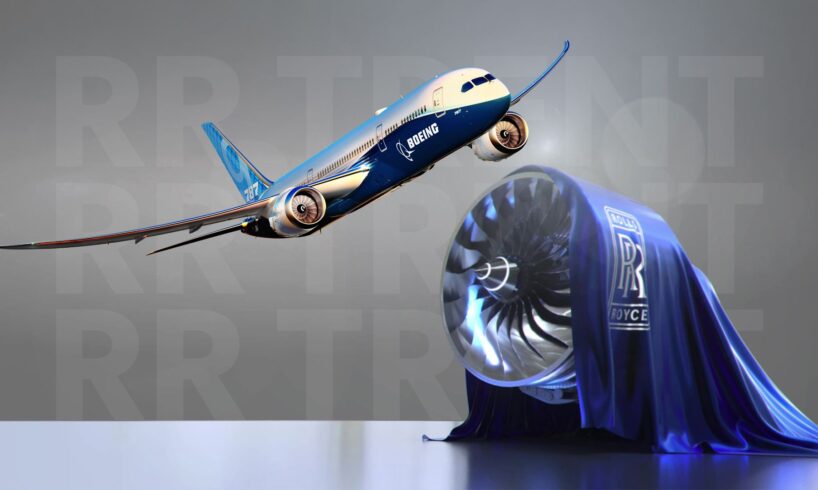
This year, Rolls-Royce’s Trent engine series celebrates 30 years. From its origins in the early 1990s, the Trent engine family has defined widebody jet propulsion. The first Trent engine entering service was the 700, on the Airbus A330 in 1995, delivering unprecedented levels of efficiency and quiet operation.
As airlines demand ever-greater efficiency, reliability, and environmental performance, the Trent series consistently delivers, earning its reputation through innovation, endurance, and operator trust. In our article, we will explain how Trent engines became dominant, what keeps them relevant today, and why their future looks equally promising.
Stock Code
RR
Business Type
Engine Maker
Date Founded
March 15, 1906
CEO
Tufan Erginbilgic
Since the Trent 700 debut in 1995, each subsequent variant, from the Rolls-Royce Trent 800 through the flagship XWB and 7000, has been built on a platform renowned for robustness. With over 6000 engines in service, more than 200 million flight hours logged, and nearly 4 billion passengers carried, examining the Trent success story offers insights into the evolution of jet propulsion.
The Genesis Of A Powerhouse: From RB211 To Trent
Photo: Stahlkocher | Wikimedia Commons
The Trent engine family traces its origins to the RB211, a revolutionary three-shaft turbofan introduced in the 1970s. Prior to this, Rolls-Royce had already cemented its legacy in pioneering propulsion, famously powering the Concorde supersonic transport with its Rolls-Royce/Snecma Olympus 593 turbojet engines, demonstrating the company’s diverse engineering capabilities across different aviation eras.
Building upon that foundation, Rolls-Royce launched the Trent 700 in the early 1990s, specifically designed for the Airbus A330. This marked the beginning of a new era, as Trent engines became synonymous with fuel efficiency and operational reliability. The Trent family consists of six main models, with thrust ratings ranging from 53,000 lbs to 97,000 lbs for widebody aircraft. The first Trent model in development was the Trent 600, initially intended for the McDonnell Douglas MD-11, though this variant was later dropped.
One of the defining features of Trent engines is their three-shaft design, which improves overall efficiency and durability by reducing mechanical stress. Unlike conventional designs, the three-shaft configuration masterfully separates the engine’s rotating components into three independent, concentric shafts.
This unique separation allows each of these crucial sections to rotate at its own optimal speed, independently of the others. This precision in rotational speed minimizes internal mechanical stresses, leads to better aerodynamic performance at each stage, and ultimately translates into superior fuel consumption and a longer operational life for the engine.
As reported by MarketScreener, Chris Cholerton, Group President of Rolls-Royce plc., said:
The Trent has been built on our relentless desire to be pioneers – to make our engines increasingly efficient, and by doing so find new ways to make flight ever more sustainable.
Smart Engineering: How Trent Engines Balance Power And Efficiency
Photo: Long Nguyen | Wikimedia Commons
One of the most impressive hallmarks of the Trent family, defining its operational success, is its superior time on wing (TOW). This critical metric determines how long an engine can stay operational on the aircraft before requiring a shop visit for major maintenance, directly impacting airline operational costs, aircraft availability, and overall fleet efficiency. Rolls-Royce’s performance in this area has truly set an industry benchmark.
Rolls-Royce has demonstrably committed to, and achieved, exceptional TOW figures. The company has set an ambitious goal of achieving 1,000 days between shop visits for its current production Trent engines, effectively doubling its previous targets and establishing a new standard for engine longevity.
This translates directly to fewer disruptions for airlines, significantly lower maintenance costs, and more predictable operational performance. In fact, Rolls-Royce proudly cites a dispatch reliability rate exceeding 99.9% for both the Trent XWB on the Airbus A350 and the Trent 7000 on the Airbus A330neo, validating their commitment to reliability.
Thanks to its robust design and cutting-edge manufacturing, the engine delivers excellent TOW, cutting costs for spare engines and maintenance while boosting aircraft utilization and profitability.
Ongoing advancements in materials and manufacturing play a key role in the Trent’s extended time on wing. The use of advanced alloys and ceramic matrix composites (CMCs) in high-stress areas boosts thermal resistance and durability. Combined with Rolls-Royce’s strict testing and quality controls, this ensures each engine delivers long-term reliability and high operational endurance.
Related
What Is The Key Difference Between Turbojets & Turbofans?
Turbojets excel in high-speed flight, while turbofans offer better efficiency. Learn about history, differences and impact on the world of aviation!
Trusted By Manufacturers: Key Partnerships With Airbus And Boeing
Photo: A350 Triebwerk TRENT XWB | Wikimedia Commons
The enduring success of the Trent line also owes much to strong partnerships with both Airbus and Boeing, with Trent engines powering nearly every major widebody platform:
Engine Model
Aircraft Application
Thrust Range, lbf (kN)
Fan Diameter, inches
(meters)
Entry Into Service (EIS)
Key Features / Notes
Trent 700
Airbus A330
67,500 – 72,000
(300 – 320)
97.4 in (2.47 m)
1995
The first Trent engine, defining widebody propulsion with high reliability and efficiency, features 26 wide-chord, hollow titanium fan blades.
Trent 800
Boeing 777
75,000 – 95,000 (334 – 415)
110 in (2.79 m)
1996
Largest diameter of any engine on the Boeing 777 at the time; notable for its robust performance and excellent dispatch reliability, capturing a significant market share.
Trent 500
Airbus A340-500/-600
53,000 – 64,000
(240 – 275)
97.4 in (2.47 m)
2002
Optimized for the ultra-long-range A340 variants, it spots a Trent 700 fan with a scaled Trent 800 core.
Trent 900
Airbus A380
70,000 – 80,000 (310 – 360)
116 in (2.95 m)
2007
Designed for the world’s largest passenger aircraft and featuring swept fan blades, it was the first Trent to introduce a contra-rotating HP spool for enhanced efficiency.
Trent 1000
Boeing 787 Dreamliner
64,000 – 78,000
(285 – 347)
112 in (2.84 m)
2011
Specifically designed for the “more-electric” Boeing 787 with bleedless architecture, it features a composite fan casing and the highest bypass ratio (10:1) of any Trent engine at its EIS.
Trent XWB
Airbus A350-900/-1000
84,000 – 97,000 (375 – 431)
118 in (3.00 m)
2015 (XWB-84)
The world’s most efficient large aircraft engine, specifically for the Airbus A350, offers up to 15% better fuel burn than previous-generation engines. The XWB-97 version provides higher thrust for the A350-1000.
Trent 7000
Airbus A330neo
68,000 – 72,000
(300 – 320)
112 in (2.84 m)
2018
The latest evolution of the A330neo, integrating Trent XWB technology (e.g., fan and aerodynamics) with the Trent 1000 architecture, delivers 14% reduced fuel burn per seat and 6 dB noise reduction compared to the Trent 700.
These partnerships are the result of decades of consistent performance, trust, and collaboration. Airlines benefit from integrated systems and engine-airframe optimization that improve fuel economy, reduce emissions, and simplify maintenance.
To confirm the success of Rolls-Royce, at the recent Paris-Le Bourget Airport airshow, the engine maker secured the following contracts:
STARLUX Airlines
: Rolls-Royce just welcomed STARLUX Airlines’ order for Trent XWB-97 engines for their A350-1000s, building on an existing fleet exclusively powered by Rolls-Royce, including Trent XWB-84 and Trent 7000 engines. This partnership highlights continued confidence in Rolls-Royce’s engine performance and support.
Riyadh Air
: The new Saudi national carrier, Riyadh Air, also placed a significant order for Trent XWB-97 engines for its A350-1000 fleet, accompanied by a Memorandum of Understanding for Rolls-Royce’s comprehensive TotalCare service, underlining the importance of the integrated support package from the outset of an airline’s operations.
Egyptair
: Rolls-Royce welcomed an order from EGYPTAIR for an additional 12 Trent XWB-84 engines, which will power six new Airbus A350-900 aircraft. This expands EGYPTAIR’s total order for Trent XWB-84 engines to 32.
Related
Rolls-Royce’s ‘Best Widebody Engine’ Just Got Even Better
Rolls-Royce is looking to make the Trent XWB turbofan more efficient and sustainable.
Engine Health Monitoring: Predictive Maintenance That Saves Millions
Photo: Dr Brains | Wikimedia Commons
A major differentiator in Trent’s success is its advanced Engine Health Monitoring system. Using over 10,000 data points transmitted per flight, the system predicts potential faults before they occur. This enables Rolls-Royce to work closely with airlines on proactive maintenance, reducing unscheduled downtime and extending engine life.
These capabilities are supported by Rolls-Royce’s global network of service hubs and digital twins, virtual models of every engine that allow real-time analytics. With this predictive model, airlines can avoid the high cost and disruption of unexpected engine removals.
Furthermore, Rolls-Royce ensures comprehensive support through its TotalCare® maintenance program, providing airlines with proactive servicing and performance optimization. This holistic approach has been instrumental in maintaining operational excellence, making Trent engines a trusted choice for flagship carriers like British Airways, Singapore Airlines, and Qatar Airways.
Designed For The Future: Sustainability, SAF, And Net-Zero Goals
Photo: Photofex_AUT | Shutterstock
The next chapter in the Trent story is sustainability. The Trent XWB‑84 stands out as the world’s most efficient large aeronautical engine, slashing fuel burn by ~15% against incumbent designs.
All current-generation Trent engines are certified to operate with up to 50% Sustainable Aviation Fuel (SAF), and Rolls-Royce aims to make them fully SAF-compatible by 2030. Newer variants, like the Trent 7000, deliver 14% reduced fuel burn per seat and a 6 dB noise reduction, thanks to a high bypass ratio (10:1) and refined fan aerodynamics.
Beyond this, the company is spearheading zero-emission propulsion research. The UltraFan engine program promises a 25% improvement in fuel efficiency compared to first-generation Trent engines. With larger fan diameters and innovative power transmission systems, the UltraFan represents the next chapter in Rolls-Royce’s pursuit of cleaner, more efficient propulsion. This new architecture is designed to be highly scalable, allowing for adaptation to various aircraft sizes and thrust requirements, ensuring its relevance for decades to come.
Rolls-Royce also recently completed the world’s first run of an ultra-efficient jet engine using 100% SAF, a milestone that affirms the company’s vision of decarbonizing long-haul aviation. This continued adaptability proves that Trent engines are not just part of aviation history, but they will definitely play a key role in aviation’s future.
Related
Rolls-Royce Trent XWB Vs. General Electric GE9X? Which Engine Is More Powerful?
The GE9X is more powerful than the Trent XWB, although there is more than thrust that makes a good engine.
The Future Of The Trent Family
Photo: fifg | Shutterstock
Looking ahead, theTrent family is positioned at the intersection of evolution and sustainability. Rolls‑Royce continues to strengthen its global manufacturing and MRO capacity, including expanded engine shops in Derby, Dahlewitz, and Singapore, with output up 50% year-on-year.
With nearly 10,000 Trent engines expected to be in service through 2040, the company is focusing not only on new platforms but also on ensuring the longevity and competitiveness of existing ones. Ultimately, the story of the Trent engine family is one of constant reinvention. In an era defined by climate goals, global fleet renewal, and tighter operational margins, the Trent family is built not just to last, but to lead.






